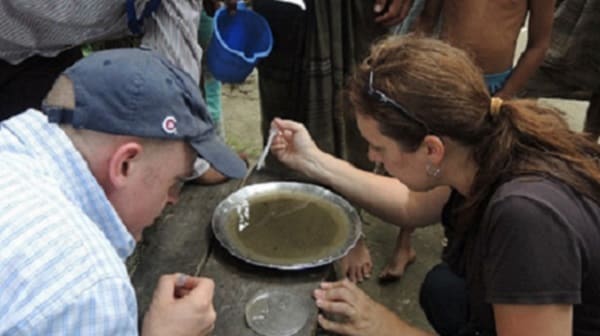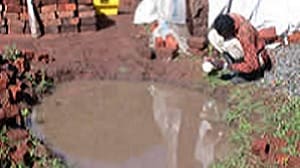Key points
- Management of aquatic larval habitats—crucial to the mosquito lifecycle—can result in significant reductions in mosquito populations.
- Larval source management (LSM) includes a suite of approaches to manage aquatic larval habitats to prevent the completion of development of immature stages.
- LSM may be an appropriate complementary intervention for malaria vectors in settings where habitats are few, fixed, and findable.

About larval control
Interventions targeting the larval stages of the mosquito have been used effectively for decades, but their effectiveness varies widely from species to species. In general, if habitats are large and amenable to environmental modification, the intervention is effective, but if habitats are small, widely dispersed, and transient the intervention is less effective.
Larval source management (LSM) includes approaches to modify, manipulate, remove, or treat mosquito larval habitats to reduce mosquito populations. With around 4000 species of mosquito on earth, and only tens which are malaria vectors, an understanding of malaria vector ecology is necessary to inform LSM strategies. For example, in settings with stable, predictable, and findable malaria vector larval habitats, LSM may be suitable.
Keep reading
Anopheles gambiae, one of the primary vectors of malaria in Africa, breeds in numerous small pools of water that form due to rainfall. However, other malaria vectors, such as An. stephensi, an invasive species on the African content,can use water storage containers, cisterns, buckets, and a wide range of habitats for larval development. It is worth noting that in Southeast Asia, Europe and the Americas, larval control programs for malaria have proven extremely effective.
Larval control may be implemented through environmental modification—draining and filling—or through use of larvicides. Though biological control using fish is often used, evidence for its effectiveness is limited.

Habitat modification, manipulation, and source reduction
Source reduction is removal or permanent destruction of mosquito breeding sites. The larval habitats may be destroyed by filling depressions that collect water, by draining swamps or by ditching marshy areas to remove standing water. Mosquitoes that breed in irrigation water can be controlled through careful water management.
Chemical larviciding
For some mosquito species, habitat elimination is not possible. For these species, chemical insecticides can be applied directly to the larval habitats. Other methods, which are less disruptive to the environment, are usually preferred:
- Oils may be applied to the water surface, suffocating the larvae and pupae. Most oils in use today are rapidly biodegraded.
- Toxins from the bacterium Bacillus thuringiensis var. israelensis (Bti) can be applied in the same way as chemical insecticides. They are very specific, affecting only mosquitoes, black flies, and midges.
- Insect growth regulators such as methroprene are specific to mosquitoes and can be applied in the same way as chemical insecticides.
Biological control
Potential biological control agents, such as fungi (e.g., Laegenidium giganteum) or mermithid nematodes (e.g., Romanomermis culicivorax), parasitize and kill larval mosquitoes but they are not efficient for mosquito control and are not widely used. Likewise, larvivorous fish, also known as mosquito fish (including Gambusia affinis) have been used in some settings to consume larval vector populations.
Other vector control interventions
Fogging or area spraying
Fogging or ultra-low volume spraying or area spraying is primarily reserved for emergency situations such as epidemics. Fogging has not been shown to be effective in any malaria-endemic areas. Fogging and area sprays must be properly timed to coincide with the time of peak adult mosquito activity, because resting mosquitoes are often found in areas that are difficult for the insecticide to reach (e.g., under leaves, in small crevices). In addition, fogging and area spraying will have to be repeatedly applied to have an impact, and it can easily become too costly to maintain.

Personal protection measures
Personal protection measures include the use of window screens, ITNs, and topical repellents (such as DEET) and wearing of light-colored clothes, long pants, and long-sleeved shirts. Well-constructed houses with window screens are effective for preventing biting by mosquitoes that bite indoors and may have contributed to the elimination of malaria from the United States and Europe. Recent evidence suggests that repellents may be effective in reducing malaria transmission and may be appropriate for areas where mosquitoes bite outdoors or early in the evening when people are not using ITNs. However, while repellents are recommended for travelers to malaria-endemic areas, further work to develop repellent formulations that are easily deployed in endemic countries is needed.
Sterile male release
Introducing sterile male mosquitoes into an area has been successfully applied in several small-scale areas. However, the need for large numbers of mosquitoes for release makes this approach impractical for most areas.
Genetic modification of malaria vectors
Genetic modification aims to develop mosquitoes that are not susceptible to the parasite. This approach is still years from application in field settings, though there have been remarkable advances in recent years in technology to allow direct modification of the mosquito genome.
